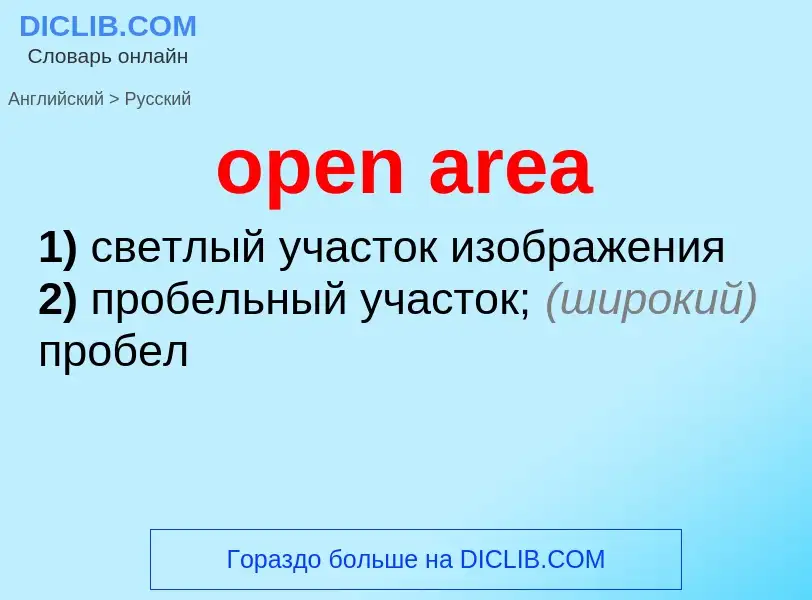Перевод и анализ слов искусственным интеллектом ChatGPT
На этой странице Вы можете получить подробный анализ слова или словосочетания, произведенный с помощью лучшей на сегодняшний день технологии искусственного интеллекта:
- как употребляется слово
- частота употребления
- используется оно чаще в устной или письменной речи
- варианты перевода слова
- примеры употребления (несколько фраз с переводом)
- этимология
open area - перевод на русский
- closed area
- controlled area
- controlled access area
- fenced area
- fingerprint pattern area
- high risk area
- inaccessible area
- key area
- limited area
- logically protected area
- monitored area
- physically protected area
- protected area
- restricted area
- secret area
- secure area
- secure storage area
- security-sensitive area
- survey area
- target area
- user area
общая лексика
разомкнутый цикл
['e(ə)riə]
общая лексика
область
район
зона
ареал
область обитания
площадь
пространство
участок
область, участок
область памяти, часть экрана
сфера деятельности
область специализации
медицина
место
плоскость
строительное дело
площадь (помещения, поверхности, фигуры и т. п.)
площадка
внутренний двор
пространство, зона
приямок (напр. у окна подвального этажа)
нефтегазовая промышленность
поверхность
зона, район, область, территория, участок
существительное
общая лексика
площадь
пространство
участок
район
область
зона
сфера (деятельности)
область (исследования и т. п.)
размах
охват
сфера
проход
ведущий к входу в подвал
приямок перед окнами подвального этажа
площадь, пространство
край
размах, сфера
дворик ниже уровня улицы, через который проходят в полуподвал
анатомия
поле (коры головного мозга)
синоним
общая лексика
единица площади
2) область (применения)
- area under crops
- area under curve
- area of ambiguity
- area of arrival
- area of departure
- area of destination
- area of substantial unemployment
- abandoned area
- accounting area
- administrative area
- arable area
- assisted area
- bad risk area
- beef-producing area
- blighted area
- built-up area
- catchment area
- census area
- central public area of bank
- crop area
- currency area
- delivery area
- depressed area
- development area
- dispersion area
- dollar area
- effective area
- enumeration area
- European free trade area
- farming area
- forage area
- franc area
- free trade area
- grass area
- gray area
- industrial area
- inland area
- labor-shortage area
- line area
- major producing area
- mapped area
- market area
- maximum work area
- metropolitan area
- mixed farming area
- monetary area
- natural area
- natural service area
- natural trading areas
- neglected area
- nonpermit area
- normal work area
- overshopped area
- overstored area
- pasture area
- pilot census area
- planted area
- ploughed area
- port area
- power supply area
- primary trading area
- productive area
- residential area
- sales area
- selling area
- service area
- shaded area
- shopping area
- single-crop area
- sown area
- sterling area
- suburban area
- tilled area
- tracted area
- treated area
- tributary area
- underprivileged areas of city
- unitary area
- unmapped area
- unproductive area
- urban settlement area
- work area
Википедия
In mathematics, an open set is a generalization of an open interval in the real line.
In a metric space (a set along with a distance defined between any two points), an open set is a set that, along with every point P, contains all points that are sufficiently near to P (that is, all points whose distance to P is less than some value depending on P).
More generally, an open set is a member of a given collection of subsets of a given set, a collection that has the property of containing every union of its members, every finite intersection of its members, the empty set, and the whole set itself. A set in which such a collection is given is called a topological space, and the collection is called a topology. These conditions are very loose, and allow enormous flexibility in the choice of open sets. For example, every subset can be open (the discrete topology), or no subset can be open except the space itself and the empty set (the indiscrete topology).
In practice, however, open sets are usually chosen to provide a notion of nearness that is similar to that of metric spaces, without having a notion of distance defined. In particular, a topology allows defining properties such as continuity, connectedness, and compactness, which were originally defined by means of a distance.
The most common case of a topology without any distance is given by manifolds, which are topological spaces that, near each point, resemble an open set of a Euclidean space, but on which no distance is defined in general. Less intuitive topologies are used in other branches of mathematics; for example, the Zariski topology, which is fundamental in algebraic geometry and scheme theory.


